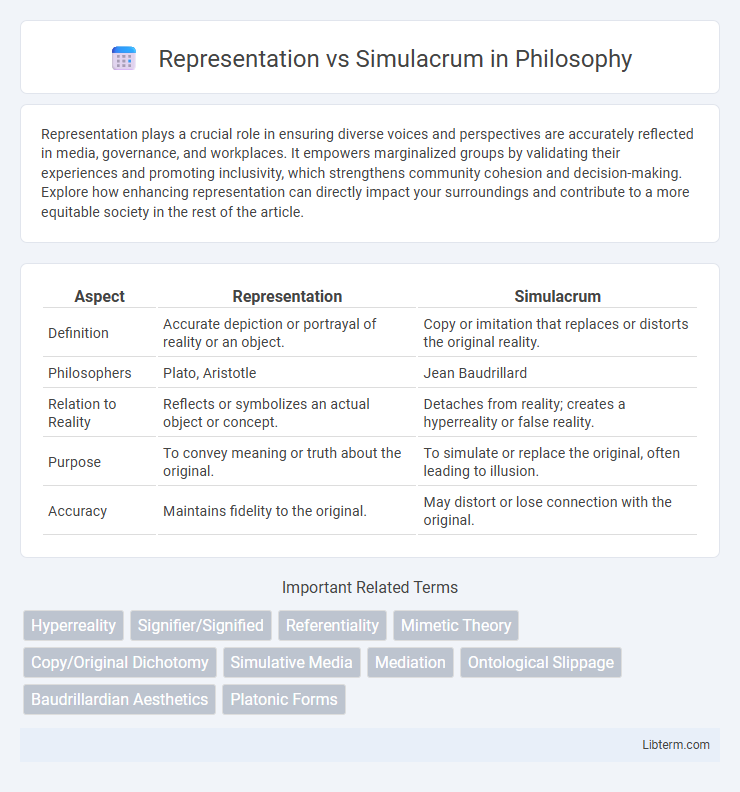Representation plays a crucial role in ensuring diverse voices and perspectives are accurately reflected in media, governance, and workplaces. It empowers marginalized groups by validating their experiences and promoting inclusivity, which strengthens community cohesion and decision-making. Explore how enhancing representation can directly impact your surroundings and contribute to a more equitable society in the rest of the article.
Table of Comparison
| Aspect | Representation | Simulacrum |
|---|---|---|
| Definition | Accurate depiction or portrayal of reality or an object. | Copy or imitation that replaces or distorts the original reality. |
| Philosophers | Plato, Aristotle | Jean Baudrillard |
| Relation to Reality | Reflects or symbolizes an actual object or concept. | Detaches from reality; creates a hyperreality or false reality. |
| Purpose | To convey meaning or truth about the original. | To simulate or replace the original, often leading to illusion. |
| Accuracy | Maintains fidelity to the original. | May distort or lose connection with the original. |
Understanding Representation in Media
Representation in media refers to the deliberate portrayal of people, events, and ideas through symbols, images, and narratives that convey meaning and reflect cultural realities. It shapes audience perception by constructing recognizable signs that connect with social and historical contexts, facilitating communication and interpretation. Understanding representation involves analyzing how media produces knowledge, reinforces ideologies, and influences identity formation through selective depiction and framing.
Defining Simulacrum: Beyond the Original
Simulacrum refers to a copy or imitation of something that no longer has an original, existing independently from any source or reality. Unlike representation, which denotes a faithful depiction tied to an original subject, simulacra create a hyperreal environment where distinctions between reality and imitation dissolve. This phenomenon challenges traditional notions of authenticity and meaning in media, art, and cultural symbols.
Historical Origins: Representation and Simulacra
The historical origins of representation trace back to classical philosophy, where Plato distinguished between the ideal forms and their imitations, emphasizing that representations are mediations of reality. Simulacra, emerging prominently in postmodern theory through thinkers like Jean Baudrillard, signify copies without an original, challenging the notion of authentic representation by creating hyperrealities. This shift illustrates a movement from representations as reflections of reality to simulacra as self-contained entities shaping perception independently of any real referent.
Key Theorists: Plato, Baudrillard, and Beyond
Plato's concept of representation emphasizes imitation of the ideal Forms, where representations are inherently inferior copies of reality. Jean Baudrillard advances this discourse by introducing the notion of simulacra, where images or signs no longer refer to any real object but instead create a hyperreality, obscuring the distinction between the real and the representation. Contemporary theorists have expanded on Baudrillard's ideas, exploring how digital media and virtual environments further challenge traditional boundaries between representation and simulacrum.
The Relationship Between Reality and its Representation
The relationship between reality and its representation is central to understanding representation versus simulacrum, where representation aims to reflect an original reality, while simulacrum replaces or distorts this reality with a copy devoid of an original. Jean Baudrillard's theory highlights how simulacra blur the boundaries between real and fake, creating hyperreality where signs and images stand independent of actual experience. This challenges traditional notions of truth and authenticity by emphasizing that what is perceived as reality may merely be a constructed simulation.
Simulacrum: Imitation Without Original
Simulacrum refers to an imitation that lacks an original reference, creating a copy without an authentic source, often leading to a distorted or hyperreal version of reality. Unlike representation, which depicts or stands for a real entity, simulacra generate a self-referential image that blurs the boundaries between reality and simulation. This concept is central to postmodern theory, illustrating how media, culture, and symbols can fabricate realities based solely on repetition and artificiality.
Examples of Representation in Popular Culture
Representation in popular culture often includes characters and narratives that embody societal values, such as superheroes symbolizing justice or diversity reflecting multicultural societies. Movies like *Black Panther* highlight Afro-futurism and racial identity, serving as powerful examples of cultural representation. Television shows like *The Simpsons* satirize everyday life while representing various social classes and ethnicities, creating relatable and meaningful content.
Instances of Simulacra in Contemporary Society
Simulacra manifest in contemporary society through hyperreal environments such as social media, where curated identities replace authentic self-representation, blurring the boundary between reality and illusion. Brands leverage simulacra by creating consumer experiences that simulate lifestyles rather than merely selling products, transforming consumption into participation in a constructed narrative. Virtual realities and digital simulations further exemplify simulacra by generating experiences indistinguishable from or even superseding physical reality, challenging traditional concepts of presence and authenticity.
Impact on Perception: Navigating Truth and Hyperreality
Representation constructs reality through selective depiction, shaping perception by filtering and interpreting experiences within cultural contexts. Simulacrum, as a copy without an original, creates hyperreality where distinctions between truth and illusion dissolve, leading to perceptions anchored in fabricated or mediated experiences. This shift challenges traditional notions of authenticity, compelling individuals to navigate a complex landscape where truth is mediated by layers of simulation.
Representation vs Simulacrum: Implications for the Future
Representation constructs meaning by referring to real-world objects or concepts, while simulacrum creates a copy without an original, challenging the distinction between reality and image. This shift impacts future communication, virtual reality, and media, where simulated experiences may replace direct interaction with authentic objects. Understanding these implications is crucial for navigating identity, truth, and authenticity in increasingly digitized environments.
Representation Infographic

 libterm.com
libterm.com